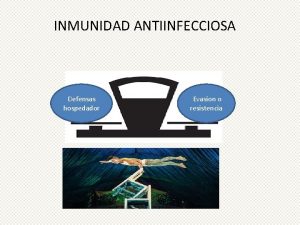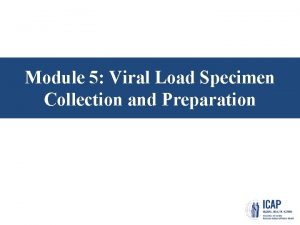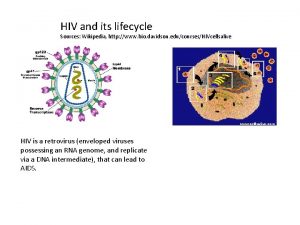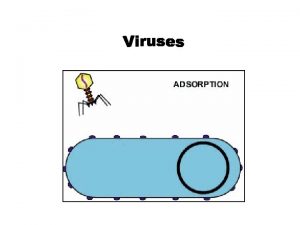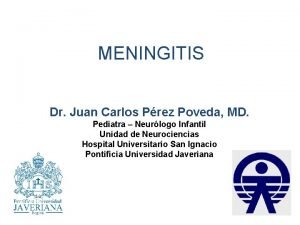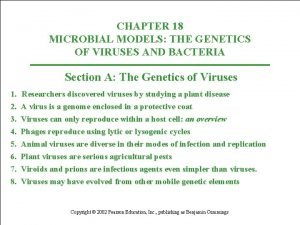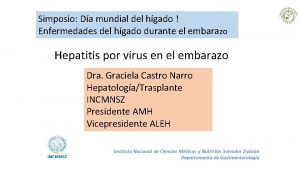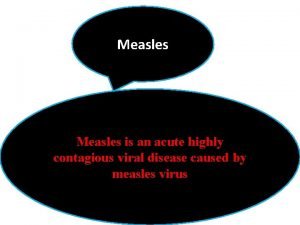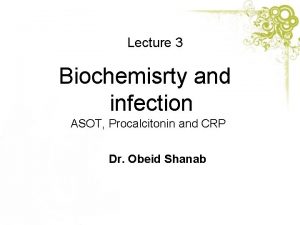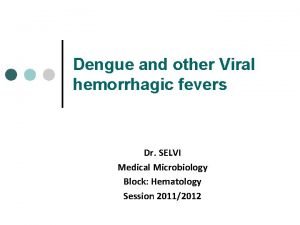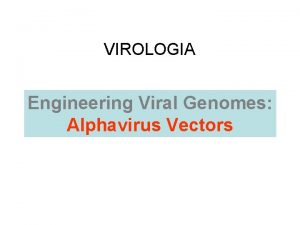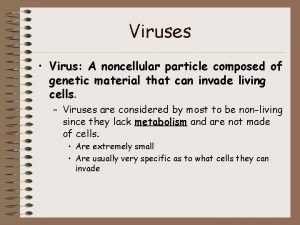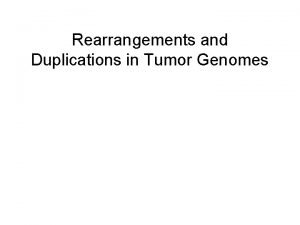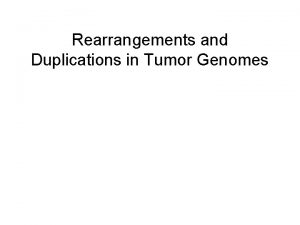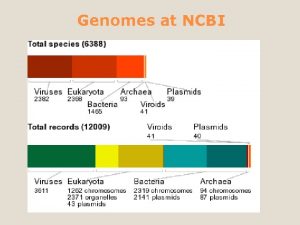Viral Genomes Virus A virus is a noncellular




































- Slides: 36

Viral Genomes

Virus • A virus is a non-cellular particle made up of genetic material and protein that can invade living cells. • Viruses are very small – smaller than the smallest cell. • They are usually surrounded by a capsid of proteins. • For replication, viruses rely on their host cells ie. , the cells they infect. • Most viruses exhibit a limited host range- they typically infect only specific types of cells of one host species.

• When infected by a virus, a host cell is forced to produce many thousands of identical copies of the original virus, at an extraordinary rate. • Unlike most living things, viruses do not have cells that divide; new viruses are assembled in the infected host cell. • Over 2, 000 species of viruses have been discovered.

• A virus consists of two or three parts: all viruses have genes made from • either DNA or RNA, long molecules that carry the genetic information; • all have a protein coat that protects these genes • some have an envelope of fat that surrounds them when they are not within a cell.

Discovery of Viruses • Edward Jenner (1796) developed a smallpox vaccine using milder cowpox viruses. • Beijerinck (1897) coined the Latin name “virus” meaning poison. • Wendell Stanley (1935) discovered viruses were made of nucleic acid and protein-TMV

Small Pox • Edward Jenner noticed that milk maids who infected with cowpox develop immunity against smallpox. • He inoculated a boy with the vesicle fluid (Pus) taken from the hand of infected maid. • The boy developed sustained immunity against smallpox. • Edward Jenner assumed that the vesicle fluid that has been taken from the hand of the milk maid contained a poison (virus ), that was responsible for immunity.


General characteristics of viruses • Viruses are smaller than bacteria, they range in size between 20 -300 nanometer (nm). • Viruses contain only one type of nucleic acid, either DNA or RNA, but never both. • Viruses consist of nucleic acid surrounded by a protein coat. • Some viruses have additional lipoprotein envelope. • Viruses lack cellular organelles, such as mitochondria and ribosomes.

• Viruses are obligate cellular parasites. • They replicate only inside living cells. • Viruses replicate through replication of their nucleic acid and synthesis of the viral protein. • Viruses do not multiply in chemically defined media. • Viruses do not undergo binary fission.

General structure of viruses • Viruses composed of nucleic acid either DNA or RNA, surrounded by a protein coat called the capsid. • The capsid is composed of small structural units called capsomeres. • The capsid protects nucleic acid from inactivation by the outer physical conditions. CAPSOMERES

• Some viruses have additional lipoprotein envelope, composed of virally coded protein and host lipid. • The viral envelope is covered with glycoprotein spikes. • Spikes to help attach to the host cell • Most viruses infect only SPECIFIC host cells. • Viruses cause many common illnesses and diseases • Some viruses may cause some cancers like leukemia – Herpes Virus, Human papilloma virus SPIKES

What do Viruses look like? • Viruses are unusual and different from other things in nature. • Viruses come in a variety of shapes. • Viruses are divided into three groups, based on the - Morphology of the nucleocapsid - The arrangement of capsomeres. • Some may be helical shape like the Ebola virus, TMV • Some may be polyhedral shapes like the influenza virus • Others have more complex shapes like bacteriophages

Types of Viruses: Helical Viruses • The virus particle is elongated or pleomorphic (not spherical), and the nucleic acid is spiral. • Caposomeres are arranged round the nucleic acid

Polyhedral Viruses • Cubic symmetry: • The virus particle is icosahedral in shape (almost spherical particle ) and the nucleic acid contained inside the capsid. • The icosahedrons particle is composed of 20 equilateral triangles and has 2, 3, 5 rotational symmetry.

Complex Viruses • The virus particle does not confirm either cubic or helical symmetry. • Bacteriophage is very common virus which is usually enclosed by capsid. • Bacteriophages contain a sheath, base plate and tail fibers • 3 types of capsid structure • Icosahedral • Filamentous • Head and tail

Life-cycle of Viruses • When a virus infects a cell (host), the virus forces it to make thousands more viruses. • It does this by making the cell copy the virus's DNA or RNA, making viral proteins, which all assemble to form new virus particles. • There are five basic, overlapping stages in the life cycle of viruses in living cells.

Stages in the life cycle of viruses • Attachment • Penetration • Replication • Assembly • Release

Attachment • Attachment : the binding of the virus to specific molecules on the surface of the cell. • This specificity restricts the virus to a very limited type of cell. • For example, the human immunodeficiency virus (HIV) infects only human T cells. • Plant viruses can only attach to plant cells and cannot infect animals. • This mechanism has evolved to favor those viruses that only infect cells in which they are capable of reproducing.

Penetration • Penetration follows attachment; viruses penetrate the host cell by endocytosis or by fusion with the cell or through injection of DNA. • Bacterial Chromosome degraded by viral enzymes. Replication of virus • Replication of virus particles is the stage where a cell uses viral RNA in its protein synthesis systems to produce viral proteins. • The RNA or DNA synthesis abilities of the cell produce the virus's DNA or RNA.

Assembly • Assembly takes place in the cell when the newly created viral proteins and nucleic acid combine to form hundreds of new virus particles. Release • Release occurs when the new viruses escape or are released from the cell. • Most viruses achieve this by making the cells burst, a process called lysis. • Other viruses such as HIV are released more gently by a process called budding.


Viral genome • A viral genome is the genetic material of the virus also termed the viral chromosome • The genome can be • DNA or RNA • Single-stranded or double-stranded • Circular or linear • Viral genomes vary in size from a few thousand to more than a hundred thousand nucleotides.

Viral Genomes • Viral genetics, the study of the genetic mechanisms that operate during the life cycle of viruses, utilizes biophysical, biological, and genetic analyses to study the viral genome and its variation.

Viral Replication • Viruses are obligate parasites that are completely dependent on the host cell for the replication and transcription of their genomes as well as the translation of the m. RNA transcripts into proteins. • Viral proteins usually have a structural function, making up a shell around the genome, but may contain some enzymes that are necessary for the virus replication and life cycle in the host cell.

RNA Viruses • An RNA virus is a virus that has RNA (ribonucleic acid) as its genetic material. • This nucleic acid is usually single-stranded RNA (ss. RNA) but may be double-stranded RNA (ds. RNA). • Notable human diseases caused by RNA viruses include Ebola hemorrhoragic fever, SARS, Rabies, common cold, influenza, hepatitis C, West Nile fever, polio and measles.


Single stranded RNA viruses • Single stranded RNA viruses can be further classified according to the sense or polarity of their RNA into negativesense and positive-sense RNA viruses. • Some are positive in that they have a "sense" strand of RNA (coded information about how to build proteins) as their genetic material. • Positive-sense viral RNA is identical to viral m. RNA and thus can be immediately translated by the host cell. • And other RNA viruses are negative in that they have an "antisense" strand (the paired opposite of the coded information).

• As such, purified RNA of a positive-sense virus can directly cause infection though it may be less infectious than the whole virus particle. • Purified RNA of a negative-sense virus is not infectious by itself as it needs to be transcribed into positive-sense RNA.

Positive Strand • Also known as a sense-strand RNA virus, a virus whose genetic information consists of a single strand of RNA that is the positive (or sense) strand which usually behaves as m. RNA (messenger RNA). • This m. RNA can be translated immediately upon infection of the host cell, producing a single protein which is modified by host and viral proteins to form the various proteins needed for replication. • Eg. PICORNAVIRUSES

Negative Strand • Also known as an antisense-strand RNA virus, a virus whose genetic information consists of a single strand of RNA that is the negative or antisense strand which does not encode m. RNA (messenger RNA) and is complementary to it. • All ss- RNA viruses with negative polarity have the enzyme transcriptase (RNA dependent RNA polymerase) inside virions. • Retroviruses and hepatitis B virus contain the enzyme reverse transcriptase. • Therefore it must be copied into the complementary plus-sense m. RNA before proteins can be made. • RHABDOVIRUSES (RHABDOVIRIDAE) • Example: Rabies virus.

Double Stranded RNA Virus • The double-stranded (ds)RNA viruses represent a diverse group of viruses that vary widely in host range - humans, animals, plants, fungi, and bacteria. • Viruses with ds. RNA genomes are currently grouped into six families: Reoviridae, Birnaviridae, Totiviridae, Partitiviridae, Hypoviridae, and Cystoviridae. • Of these six families, the Reoviridae is the largest and most diverse in terms of host range. • The double stranded RNA viruses replicate in the cytoplasm, and their replication is monocistronic (m. RNA that can encode only one polypeptide per RNA molecule). • Example is the Reovirus.

DNA Viruses • DNA virus is a virus that has DNA (deoxyribonucleic acid) as its genetic material. • The nucleic acid is usually double-stranded DNA (ds. DNA) but may also be single-stranded DNA (ss. DNA). • They are usually Large, Icosahedral, enveloped in Lipoproteins. • Do not have polymerase enzymes, and cause Latent infection.

• DNA viruses belong to either Group I or Group II of the Baltimore classification system for viruses. • Single-stranded DNA is usually expanded to doublestranded in infected cells. • Examples include Poxviruses, Hepadnaviruses, Hepatitis b. Herpesviruses,


Baltimore Classification • Viruses were divided into six groups based on their nucleic acid and m. RNA production. Class 1 - ds-DNA viruses. Class 2 - ss-DNA viruses. Class 3 - ds- RNA viruses. Class 4 - ss-RNA viruses with positive strands ( positive polarity). Class 5 - ss-RNA viruses with negative strands (negative polarity). Class 6 - ss-RNA viruses associated with the enzyme reverse transcriptase.

• Class I viruses contain a single molecule of double stranded DNA and are exemplified by adenovirus, simian virus 40 (SV 40), herpes viruses, and human papilloma viruses. • Class II viruses are also called parvo viruses and are made of single stranded DNA that is copied in to double stranded DNA before transcription in the host cell. • Class III viruses are double stranded RNA viruses - Rotavirus. • Class IV viruses, typified by poliovirus, have single plus strand genomic RNA that serves as the m. RNA. • Class V viruses contain a single negative strand RNA which serves as the template for the production of m. RNA by specific virus enzymes. • Class VI viruses which contains an enzyme reverse transcriptase- Hepatitis Virus.
 Chapter 18 genomes and their evolution
Chapter 18 genomes and their evolution Computational biology: genomes, networks, evolution
Computational biology: genomes, networks, evolution Quizlet
Quizlet Antiperytique
Antiperytique Rhinopneumonitis definition
Rhinopneumonitis definition Ciclo viral
Ciclo viral Hemolyzed serum sample
Hemolyzed serum sample Viral replikasyon basamakları
Viral replikasyon basamakları Itil wikipedia fr
Itil wikipedia fr Viral arthritis
Viral arthritis The dynamics of viral marketing
The dynamics of viral marketing Vaccins à vecteur viral
Vaccins à vecteur viral Spasmodic croup vs viral croup
Spasmodic croup vs viral croup Aerochamber definition
Aerochamber definition Viral shedding
Viral shedding Viral dna
Viral dna Meningitis
Meningitis Capsid capsomere
Capsid capsomere Viral inoculation in embryonated egg
Viral inoculation in embryonated egg Trplice
Trplice Hepatitis viral
Hepatitis viral An acute highly contagious viral disease
An acute highly contagious viral disease Viral receptors
Viral receptors Varicela variola
Varicela variola Replicação viral ciclo lítico e lisogênico
Replicação viral ciclo lítico e lisogênico Eline's viral
Eline's viral Rotarix live attenuated
Rotarix live attenuated Viral
Viral Viral inoculation in embryonated egg
Viral inoculation in embryonated egg Bacterial vs viral vs fungal meningitis csf
Bacterial vs viral vs fungal meningitis csf Viral life cycle
Viral life cycle Procalcitonin
Procalcitonin Causes of viral hemorrhagic fever
Causes of viral hemorrhagic fever Decapsidação
Decapsidação Section 24-1 viral structure and replication
Section 24-1 viral structure and replication Viral communications
Viral communications Viral entry
Viral entry





